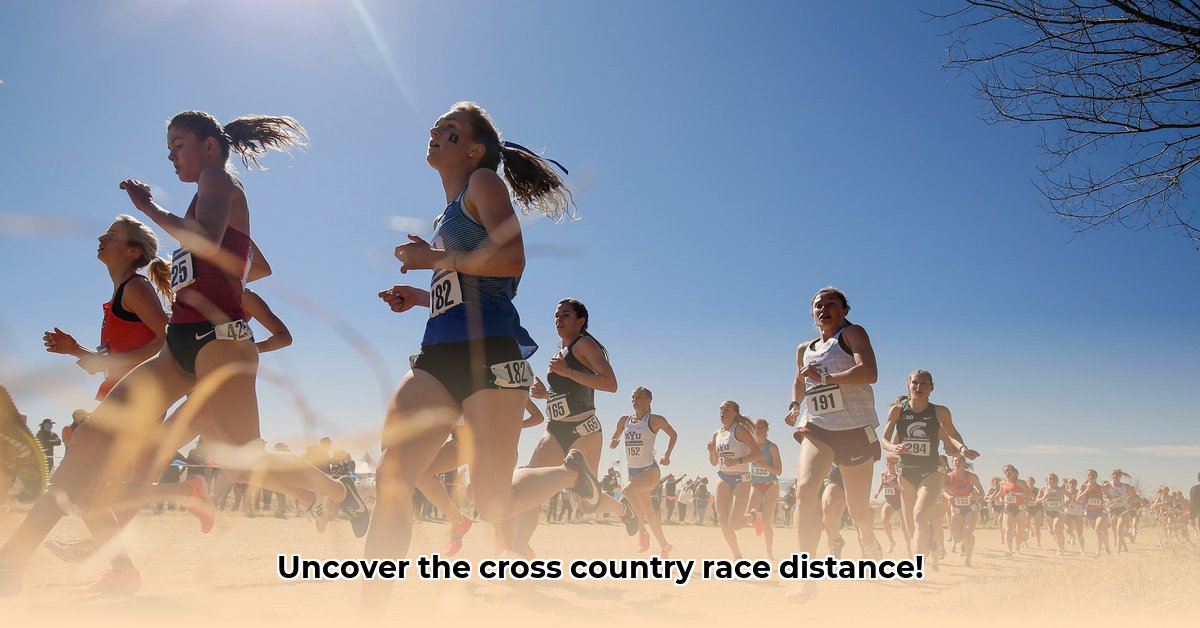Cross country racing, known for its varied terrains and challenging courses, doesn’t have a one-size-fits-all distance. Race lengths vary based on competition level, age group, and even location, adding complexity to training and race strategy. This guide provides a comprehensive overview of common cross country race lengths, exploring the reasons behind these variations and delving into the debate surrounding distance standardization. Whether you’re a budding high school runner, a collegiate athlete aiming for nationals, an experienced marathoner exploring new challenges, or a coach developing training programs, understanding these nuances is crucial for success. For reference on common race distances, check out this helpful conversion tool: Metric to Feet.
High School Cross Country: Building a 5K Base
High school cross country predominantly uses the 5K (3.1 miles) distance for varsity-level competition, applying to both boys and girls. This distance strikes a balance between challenging young athletes and fostering manageable training regimens. Coaches typically emphasize a blend of speed work, including interval and tempo runs, and endurance-building long runs to prepare athletes for the 5K demand. However, junior varsity and freshman races often feature shorter distances, generally between two and three miles. This approach allows younger, less experienced runners to develop their skills and stamina gradually, minimizing injury risk while building a foundation for the 5K distance in later years. This phased approach also promotes inclusivity, encouraging participation from runners of varying abilities.
Collegiate Cross Country: Mastering the 8K and Beyond
The collegiate level elevates the challenge. While the 8K (approximately 5 miles) has become the prevalent standard for both men and women, variations still exist, particularly in championship races. This increased distance requires a significant step up in training intensity and strategic pacing compared to high school. Collegiate runners must adapt their training to incorporate longer runs at varied paces, hill work to build strength and stamina, and tempo runs to develop a sustainable race pace. The 8K demands both physical and mental resilience, pushing athletes to strategize their energy expenditure and maintain focus throughout the grueling course. The historical discrepancies in collegiate race distances, with women previously running shorter courses, have fueled the ongoing debate on gender equity and standardization in the sport. The push for equal distances reflects a broader movement towards inclusivity and equitable competition opportunities.
International Cross Country: Embracing Global Variation
International cross country competitions, such as the World Athletics Cross Country Championships, showcase the sport’s global reach and embrace a wider range of distances and course types. While a push for greater standardization exists, particularly at the elite level, these events often incorporate varying lengths to accommodate different age groups and competitive levels. This variation adds an element of unpredictability and necessitates adaptability from athletes who must prepare for a wider range of race scenarios. Unlike the more predictable track environment, international cross country courses can feature challenging terrains like hills, mud, sand, and water crossings. This diversity requires not only physical prowess but also sharp tactical awareness and the ability to adapt quickly on unpredictable terrain.
The Standardization Debate: Seeking Balance
The discussion around standardizing cross country race distances continues to divide the running community. Proponents argue that a uniform distance promotes fairness, simplifies training, facilitates performance comparisons, and reflects a commitment to gender equity. A standard distance would provide a more level playing field, allowing for direct comparisons between athletes regardless of location or competition level. Opponents, however, value the sport’s tradition of diverse race formats, arguing that varied distances cater to different athletic strengths and acknowledge course variations. They believe that maintaining a degree of flexibility allows the sport to remain accessible to a broader range of runners with varying skill sets and preferences. Finding the right balance between standardization and preserving the sport’s historical diversity remains a central challenge for the future of cross country.
Training for Cross Country Success: Adapting to the Challenge
Regardless of the specific race distance, successful cross country running hinges on effective training tailored to the demands of the course. For shorter, faster races like the high school 5K, training emphasizes speed work, interval training, and tempo runs to improve speed and efficiency, coupled with sufficient endurance training to sustain a fast pace. Longer races, such as the collegiate 8K and international events, necessitate a greater focus on endurance building through long runs at varying paces, hill training to build strength and resilience, and tempo runs to develop a sustainable race pace. Strength training is also crucial, improving muscle power and preventing injuries common in the demanding sport. Finally, race-day tactics, including pacing, course familiarity, and adapting to changing conditions during the race, play a pivotal role in maximizing performance. Understanding the specific demands of each race distance and tailoring training accordingly unlocks a runner’s full potential.
- Unlock Ancient Roman Jewelry’s Secrets: History, Materials, & Symbolism Revealed - August 14, 2025
- Unveiling Ancient Roman Mythical Creatures: Legends, Powers & Origins Defined for Today’s Enthusiast - August 14, 2025
- Unlock Ancient Secrets: Ancient Roman Attire Women, Status, & Materials [Guide] - August 14, 2025
















